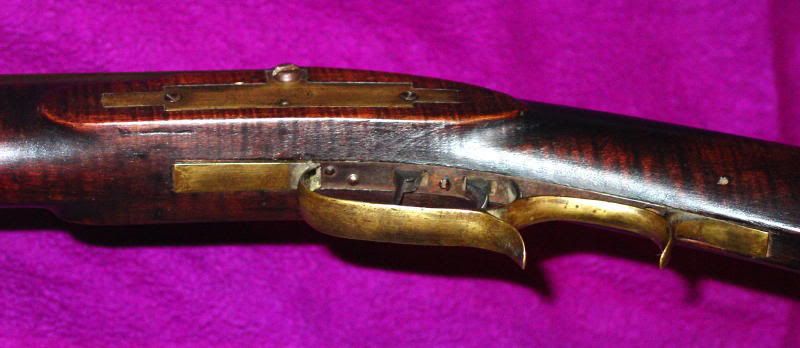Also listed under "Plains Rifle"
Much like the "R. Bishop" rifle, this one is a monster.....and large caliber. This one has a bit shorter barrel than the Bishop, so might qualify as a "Plains Rifle" by Hanson's definition, but I think it's more specialized than that....another "Buffalo Gun"! Some might want to claim it as a "chunk gun", but chunk guns are not usually .56 caliber.
James R. McQuaid was born in Clearfield County, Pennsylvania in 1818. He was married in 1840, in Huntington County, Pennsylvania to Mrs. Elizabeth Patton. McQuaid arrived in Canton, Fulton County, Illinois, on November 13, 1844 and immediately "commenced the manufacture of guns". He soon enjoyed an excellent reputation as a maker of "trusty and accurate rifles". Fulton County History books say that McQuaid manufactured rifles "from the rough iron", rather than using barrel blanks that had become commercially available by then. This is supported by the 1850 Industrial census which indicates that McQuaid bought 220 lbs. of "iron & steel" for $15. Most other gunsmiths who were listed bought "gun barrels" or "gun blanks", which would have cost considerably more. He employed three men in his shop, whose wages totaled $100 per month, and produced 60 guns valued at $1,000. The 1850 population census lists two other gunsmiths, living in the McQuaid household. These were no doubt two of the three employees listed in the Industrial census. They were: Lewis B. Thorp, age 19, born in New York; and Daniel Cline (Kline?), age 19, born in Germany. James Donn, who later became a well known maker in Canton, was also apprenticed to McQuaid.
McQuaid's advertisements in local newspapers are lengthy and quite detailed. Plain fullstock rifles with patchboxes were #12 to $14; halfstocks were from $15 to $18. (surprised?) His ad goes on to list added options regarding patchboxes, silver mountings, etc. He retired from the gunsmithing business in 1856, due to ill health, but lived another 41 years. He died July 9, 1897 while visiting his daughter in Oakland, California. I can't help but wonder whether his "ill health" might have been failing eyesight.
This rifle is fairly plain, although very well made. However, one of the most ornate rifles I have seen by an Illinois maker was made by McQuaid, and is quite comparable to the M. L. Barrett rifle, which is also in our virtual museum. Here are the vital statistics on this rifle.
Overall length: 55 1/2"
Barrel length: 40 3/4" (but has been shortened 4" to 5" at the muzzle) Barrel is hand forged.
Width across flats: at breech 1 5/16"; at muzzle 1 1/4"
Caliber: .56, with seven groove rifling
Stock: maple
Length of pull: 12 7/8"














